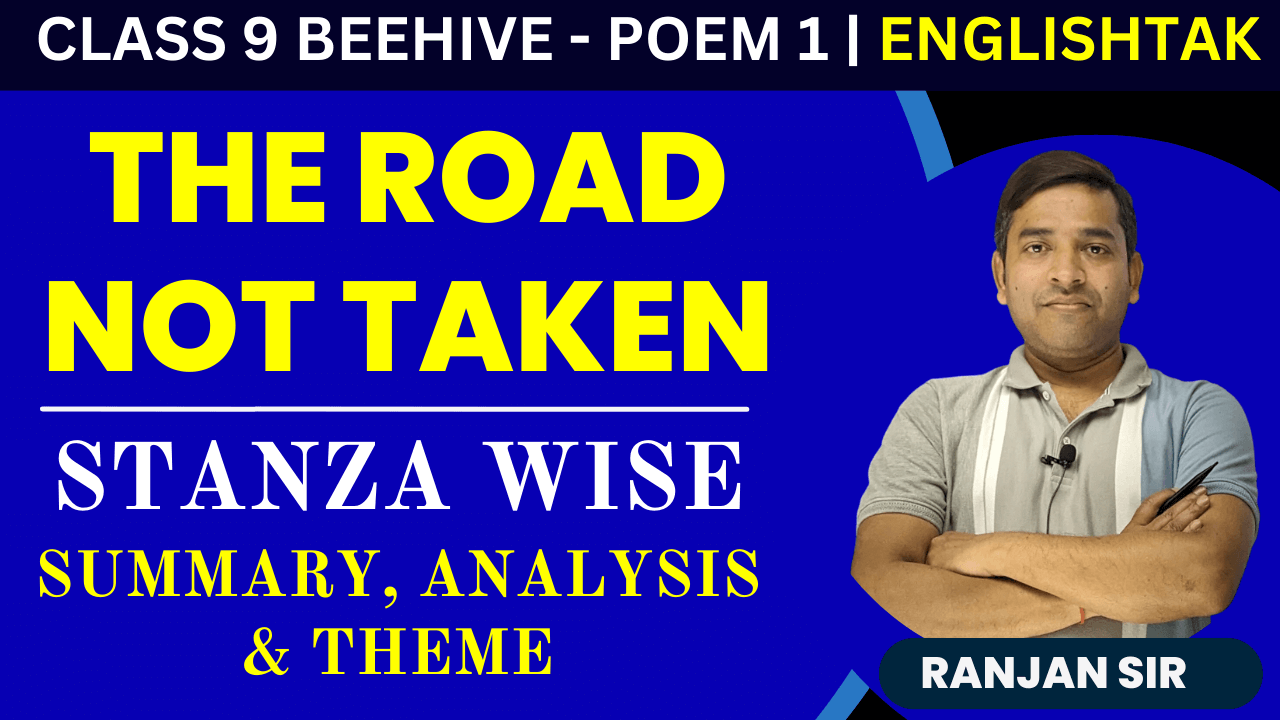![]()
The Road Not Taken Summary & Analysis
Introduction: “The Road Not Taken” is a reflective and introspective poem by Robert Frost, in which the speaker stands at a crossroads in a forest, faced with a significant life decision. The poem uses the metaphor of two diverging roads in a wood to explore the consequences of choices and the feelings of uncertainty and reflection that come with making decisions. The Road Not Taken Summary & Analysis.
Stanza 1: The Road Not Taken Summary & Analysis
The poem begins with the speaker describing a moment when he comes across a fork in the road while walking through a yellow forest, signifying autumn. He feels regretful that he cannot take both paths and explore all possibilities. As a lone traveler, he is forced to make a decision and carefully considers which road to choose. He stands for a long time, analyzing one road as far as he can see, trying to predict where it will lead. The road eventually bends into the undergrowth, preventing him from seeing its complete course. This represents the limits of foresight; the speaker can only make an informed guess about what the future holds.
कविता की शुरुआत उस क्षण से होती है जब वक्ता एक जंगल में चलते हुए एक दोराहे पर पहुंचता है, जहाँ रास्ते अलग-अलग दिशाओं में बंटते हैं। यह पीले पत्तों वाला जंगल पतझड़ का प्रतीक है। वक्ता को इस बात का अफसोस है कि वह दोनों रास्तों पर नहीं चल सकता और सभी संभावनाओं का अनुभव नहीं कर सकता। एक अकेला यात्री होने के नाते, उसे एक फैसला लेना पड़ता है। वह सोच-समझकर इस बात पर विचार करता है कि कौन सा रास्ता चुने। वह काफी समय तक एक रास्ते को देखता रहता है, जितना दूर तक उसकी नजर जाती है, यह समझने की कोशिश करता है कि यह रास्ता उसे कहाँ ले जाएगा। लेकिन अंत में वह रास्ता झाड़ियों में जाकर मुड़ जाता है, जिससे वक्ता पूरा रास्ता नहीं देख पाता। यह सीमित दृष्टिकोण का प्रतीक है; वक्ता भविष्य के बारे में सिर्फ अनुमान लगा सकता है, लेकिन उसे पूरी तरह से जान नहीं सकता।
Stanza 2: The Road Not Taken Summary & Analysis
After examining the first road, the speaker decides to take the second one, which seems equally appealing. He justifies his choice by suggesting that the second road is “grassy and wanted wear,” implying that it has been less traveled and might offer a unique experience. However, he immediately reconsiders this thought and acknowledges that both roads were actually worn about the same. This suggests that the difference between the two paths may not be as significant as it initially appeared, emphasizing the idea that life’s choices often seem more distinct than they truly are.
पहले रास्ते को अच्छी तरह से देखने के बाद, वक्ता फैसला करता है कि वह दूसरा रास्ता लेगा, जो देखने में भी उतना ही आकर्षक लगता है। वह अपने चुनाव को इस तरह सही ठहराता है कि दूसरा रास्ता घास से ढका हुआ है और ऐसा लगता है जैसे उस पर कम लोग चले हैं, जिससे उसे एक अनोखा अनुभव मिल सकता है। हालांकि, तुरंत बाद वह अपनी इस सोच पर दोबारा विचार करता है और मानता है कि वास्तव में दोनों रास्ते लगभग एक जैसे ही घिसे-पिटे थे। इसका मतलब यह है कि दोनों रास्तों में जितना अंतर उसे शुरू में लगा था, उतना असल में नहीं था। यह बात इस ओर इशारा करती है कि जीवन के चुनाव अक्सर जितने अलग दिखाई देते हैं, वे वास्तव में उतने अलग नहीं होते।
Stanza 3: The Road Not Taken Summary & Analysis
In the third stanza, the speaker observes that both roads are covered in leaves that have not been trodden black, meaning neither path had been walked on recently. It’s a fresh day with new opportunities. He convinces himself that he will keep the first road for another day, imagining that he might come back and explore the other option later. However, he immediately doubts this possibility because he understands how “way leads on to way.” Once a choice is made, one decision leads to another, and it’s unlikely he will return to this same spot to choose differently. This realization reflects the irreversible nature of life choices and the uncertainty about whether we can revisit them.
तीसरे पद में, वक्ता यह देखता है कि दोनों रास्ते पत्तों से ढके हुए हैं, जिन पर अभी तक किसी ने चलकर उन्हें काला नहीं किया है, जिसका मतलब है कि हाल ही में किसी ने उन पर कदम नहीं रखा। यह एक नया दिन है और नई संभावनाएं मौजूद हैं। वह खुद को समझाता है कि वह पहला रास्ता किसी और दिन के लिए छोड़ देगा, यह सोचकर कि वह बाद में लौटकर उस विकल्प को भी देख सकेगा। हालांकि, तुरंत ही वह इस संभावना पर संदेह करता है, क्योंकि उसे एहसास होता है कि “एक रास्ता दूसरे की ओर ले जाता है।” एक बार जब कोई निर्णय ले लिया जाता है, तो एक फैसला दूसरे फैसले की ओर ले जाता है, और यह काफी असंभव है कि वह दोबारा उसी स्थान पर लौटकर दूसरा रास्ता चुन सकेगा। यह एहसास जीवन के निर्णयों की अपरिवर्तनीय प्रकृति और इस बात की अनिश्चितता को दर्शाता है कि हम कभी भी उन विकल्पों की ओर लौट पाएंगे या नहीं।
Stanza 4: The Road Not Taken Summary & Analysis
The final stanza shifts to the future, where the speaker imagines looking back on this moment with a sigh. He predicts that, in the future, he will reflect on his choice and tell the story of how he “took the one less traveled by.” The speaker believes that choosing the less popular or conventional path has made a significant impact on his life. However, the tone of the “sigh” suggests that his reflection might be filled with a mixture of contentment, nostalgia, or even regret. The closing line, “And that has made all the difference,” is ambiguous: it could imply that the speaker is either satisfied with the outcome or that he wonders about what might have been had he chosen differently. The poem leaves the interpretation open, allowing readers to reflect on their own choices and the roads they have taken in life.
अंतिम पद में वक्ता भविष्य की ओर मुड़ता है, जहाँ वह इस क्षण को एक आह भरते हुए याद करता है। वह कल्पना करता है कि भविष्य में वह अपने इस चुनाव पर विचार करेगा और बताएगा कि उसने “कम चले गए” रास्ते को चुना था। वक्ता का मानना है कि कम लोकप्रिय या पारंपरिक रास्ता चुनने से उसके जीवन पर महत्वपूर्ण प्रभाव पड़ा है। हालाँकि, “आह” के स्वर से यह संकेत मिलता है कि उसकी यह सोच संतोष, पुरानी यादों, या शायद पछतावे से भरी हो सकती है। अंतिम पंक्ति, “And that has made all the difference,” अस्पष्ट है: यह या तो इस बात की ओर इशारा कर सकती है कि वक्ता अपने निर्णय से संतुष्ट है, या फिर वह यह सोच रहा है कि अगर उसने दूसरा रास्ता चुना होता तो क्या हुआ होता। यह कविता पाठकों के लिए अपने जीवन के चुनावों और उनके द्वारा चुने गए रास्तों पर विचार करने का अवसर छोड़ देती है, जिससे हर व्यक्ति अपनी अलग व्याख्या कर सकता है।
Theme of the Poem “The Road Not Taken” In English:
At its core, the poem “The Road Not Taken” revolves around the theme of choices and their consequences. It explores how every decision we make shapes the course of our lives, even though we cannot predict the full outcomes of those decisions. The poem highlights the inevitability of choice in life and how, once a path is chosen, it is nearly impossible to return and choose differently. The speaker reflects on the choice of taking a less conventional or less traveled path, suggesting a desire to assert individuality and uniqueness. However, the poem also expresses the uncertainty and ambiguity that comes with making decisions—whether the speaker is ultimately satisfied or regretful remains unclear. This ambiguity captures the complexity of human life, where every decision carries both opportunity and consequence.
Theme of the Poem “The Road Not Taken” In Hindi (हिंदी में):
कविता “The Road Not Taken” की मुख्य विषयवस्तु चुनाव और उसके परिणामों के इर्द-गिर्द घूमती है। यह इस बात को दर्शाती है कि कैसे हर निर्णय जो हम लेते हैं, हमारे जीवन की दिशा को प्रभावित करता है, भले ही हम उन निर्णयों के परिणामों को पूरी तरह से पहले से नहीं जान सकते। कविता जीवन में चुनाव की अनिवार्यता को उजागर करती है और यह भी कि एक बार कोई रास्ता चुन लेने के बाद, फिर से लौटकर दूसरा रास्ता चुनना लगभग असंभव होता है। वक्ता उस रास्ते पर चलने के निर्णय पर विचार करता है जो कम पारंपरिक या कम चुना गया था, जिससे उसकी अपनी विशिष्टता और व्यक्तित्व को स्थापित करने की इच्छा जाहिर होती है। हालांकि, कविता में निर्णय लेने के साथ आने वाली अनिश्चितता और अस्पष्टता भी झलकती है—चाहे वक्ता अपने चुनाव से संतुष्ट है या पछता रहा है, यह स्पष्ट नहीं है। यह अस्पष्टता जीवन की जटिलता को दर्शाती है, जहाँ हर निर्णय में अवसर और परिणाम दोनों निहित होते हैं।
Conclusion:
At its core, “The Road Not Taken” explores the themes of choice, individuality, and the passage of time. It delves into the nature of decision-making and the inevitable consequences that follow. The speaker’s reflection on the road “less traveled” suggests a desire to assert individuality, but the poem also acknowledges the uncertainty that accompanies every choice. In the end, the speaker recognizes that life is shaped by the choices we make, even when we cannot foresee their full consequences. Whether the speaker feels satisfaction or regret remains unclear, capturing the complexity of human decision-making and the tension between opportunity and consequence.
मूल रूप से, “The Road Not Taken” कविता चुनाव, व्यक्तित्व, और समय के बीतने जैसे विषयों का गहन विश्लेषण करती है। यह निर्णय लेने की प्रकृति और उसके साथ आने वाले अनिवार्य परिणामों पर प्रकाश डालती है। वक्ता का “कम चले गए” रास्ते पर विचार करना उसके अपने व्यक्तित्व को स्थापित करने की इच्छा को दर्शाता है, लेकिन यह भी स्वीकार करती है कि हर निर्णय के साथ अनिश्चितता जुड़ी होती है। अंत में, वक्ता इस बात को समझता है कि जीवन उन चुनावों से आकार लेता है जो हम करते हैं, भले ही हम उनके सभी परिणामों को पहले से न जान पाएं। वक्ता संतुष्ट है या पछतावे में है, यह स्पष्ट नहीं है, जो यह बताता है कि मानव निर्णय प्रक्रिया कितनी जटिल होती है और कैसे अवसरों और परिणामों के बीच तनाव बना रहता है।
English For CBSE Class 9
The Fun They Had Class 9 MCQ Questions
The Fun they Had Questions Answers





